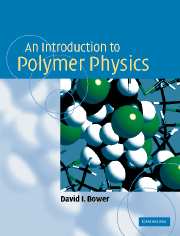Book contents
- Frontmatter
- Contents
- Preface
- Acknowledgements
- 1 Introduction
- 2 Some physical techniques for studying polymers
- 3 Molecular sizes and shapes and ordered structures
- 4 Regular chains and crystallinity
- 5 Morphology and motion
- 6 Mechanical properties I – time-independent elasticity
- 7 Mechanical properties II – linear viscoelasticity
- 8 Yield and fracture of polymers
- 9 Electrical and optical properties
- 10 Oriented polymers I – production and characterisation
- 11 Oriented polymers II – models and properties
- 12 Polymer blends, copolymers and liquid-crystal polymers
- Appendix: Cartesian tensors
- Solutions to problems
- Index
7 - Mechanical properties II – linear viscoelasticity
Published online by Cambridge University Press: 05 June 2012
- Frontmatter
- Contents
- Preface
- Acknowledgements
- 1 Introduction
- 2 Some physical techniques for studying polymers
- 3 Molecular sizes and shapes and ordered structures
- 4 Regular chains and crystallinity
- 5 Morphology and motion
- 6 Mechanical properties I – time-independent elasticity
- 7 Mechanical properties II – linear viscoelasticity
- 8 Yield and fracture of polymers
- 9 Electrical and optical properties
- 10 Oriented polymers I – production and characterisation
- 11 Oriented polymers II – models and properties
- 12 Polymer blends, copolymers and liquid-crystal polymers
- Appendix: Cartesian tensors
- Solutions to problems
- Index
Summary
Introduction and definitions
Introduction
In section 6.1 it is pointed out that, at low temperatures or high frequencies, a polymer may be glass-like, whereas at high temperatures or low frequencies it may be rubber-like. In an intermediate range of temperature or frequency it will usually have viscoelastic properties, so that it undergoes creep under constant load and stress-relaxation at constant strain. The fundamental mechanisms underlying the viscoelastic properties are various relaxation processes, examples of which are described in section 5.7. The present chapter begins with a macroscopic and phenomenological discussion of linear viscoelasticity before returning to further consideration of the fundamental mechanisms.
Consider first the deformation of a perfect elastic solid. The work done on it is stored as energy of deformation and the energy is released completely when the stresses are removed and the original shape is restored. A metal spring approximates to this ideal. In contrast, when a viscous liquid flows, the work done on it by shearing stresses is dissipated as heat. When the stresses causing the flow are removed, the flow ceases and there is no tendency for the liquid to return to its original state. Viscoelastic properties lie somewhere between these two extremes.
- Type
- Chapter
- Information
- An Introduction to Polymer Physics , pp. 187 - 219Publisher: Cambridge University PressPrint publication year: 2002
- 1
- Cited by



